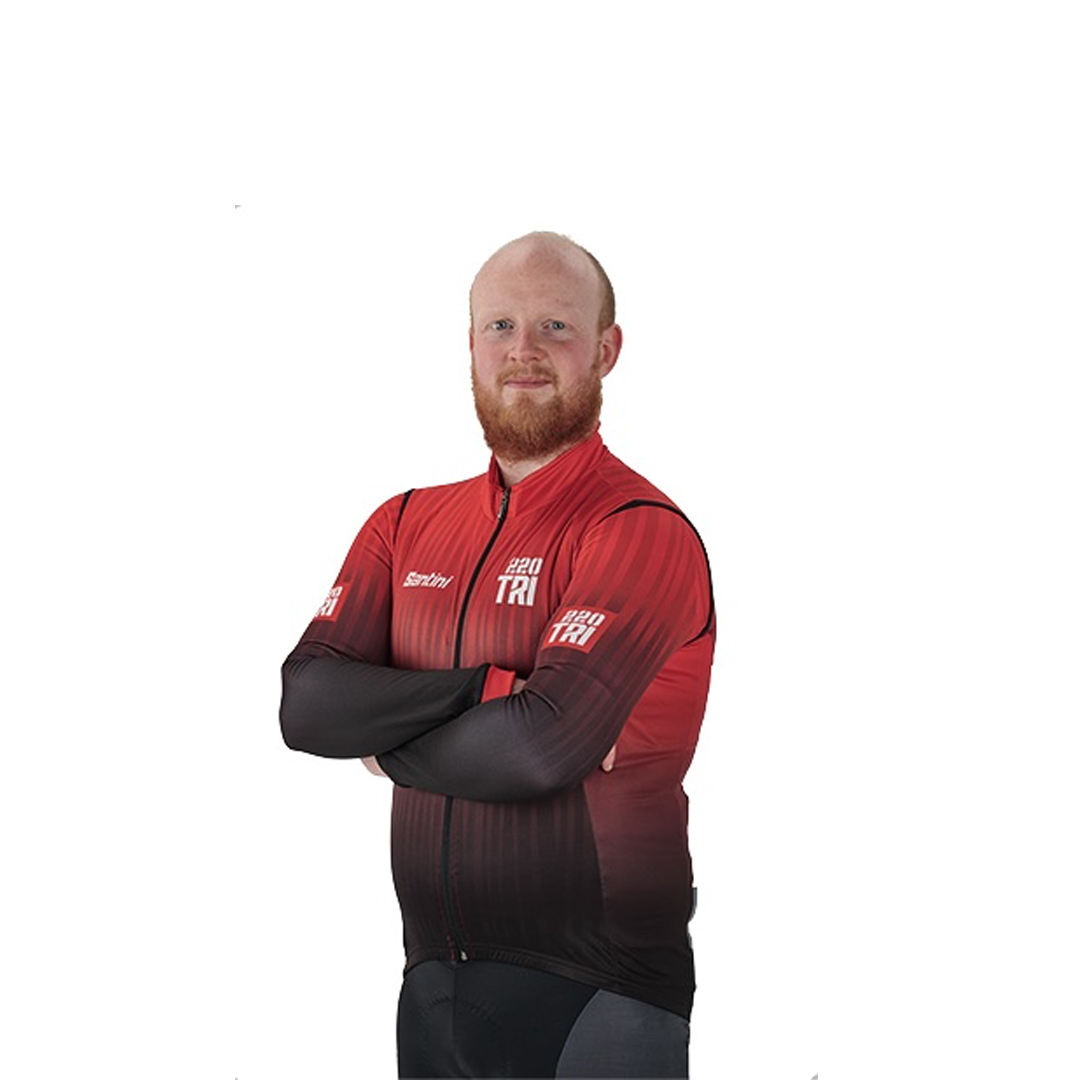Triathlon bikes may be more difficult to handle because of their geometry, but they're popular because the positives far outweigh the negatives, by limiting their weaknesses to allow them to go faster over 180km compared to a road bike.
But what two-wheeled stallion should you be handing over cash for? And how did triathlon bikes even become a thing? Let's take a look...
Jump to:
- How we tested
- The birth of triathlon bikes
- Best triathlon bikes reviewed
- Features of a triathlon bike
- How much time can you save on a triathlon bike?
- When should you not use one?
The best triathlon bikes reviewed
Canyon Speedmax CFR eTap
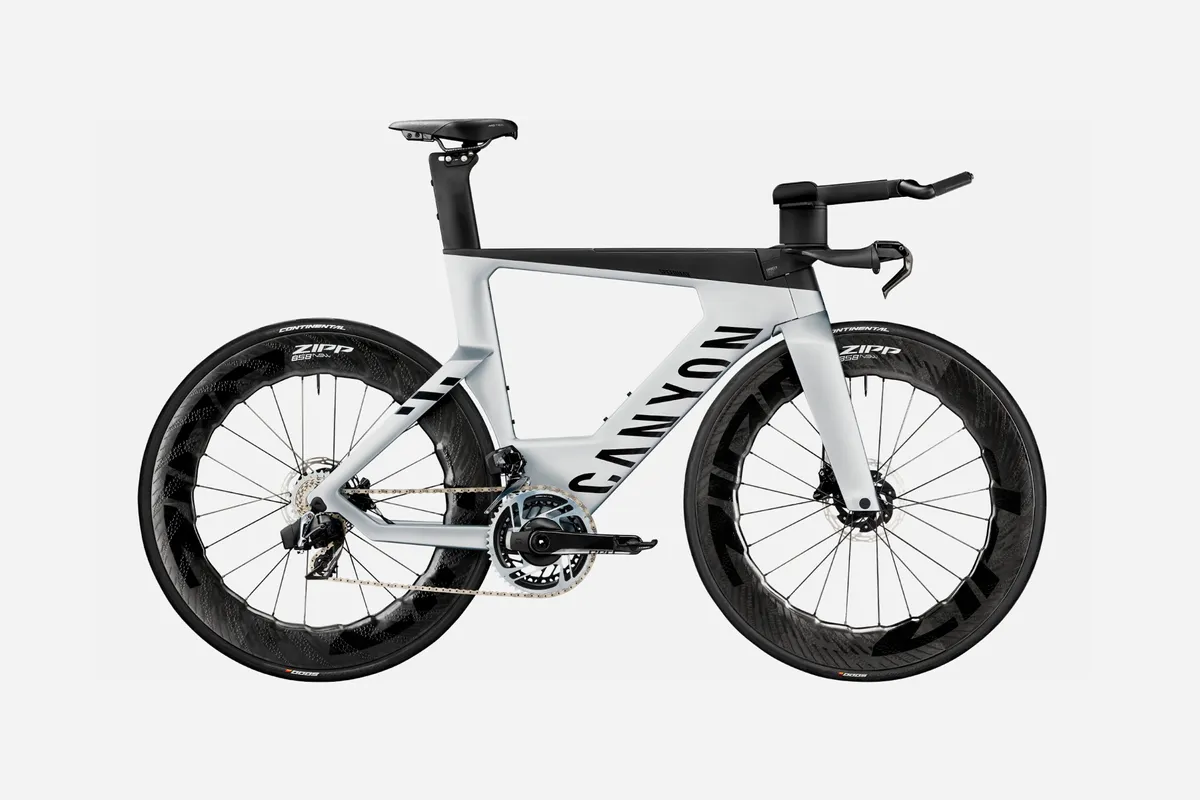
- Price: £11,449
- Pros: Clever integration, highly adjustable, used by world champions
- Cons: Expensive, a little heavy
Canyon Speedmax riders have now won the Ironman World Championships five times.
This top-of-the-range model includes integrated storage and hydration, an adjustable carbon cockpit, Zipp 858 wheels and a built-in power meter.
The storage is ingenious, with the hydration bladder packed inside the frame under the bento box.
Meanwhile, the ride is sublime on flats and on descents, and surprisingly stable even with deep wheels.
The Speedmax isn’t super light at over 9kg, but you’ll save weight not needing to add storage other than bottles.
This superbike has a huge price tag, but it’s also close to having everything we’d want for triathlon.
See the full verdict in our Canyon Speedmax CFR Disc eTap review.
Verdict: World-beating speed and the best integration on a triathlon bike yet.
Score: 93%
Argon 18 E119 Tri Disc
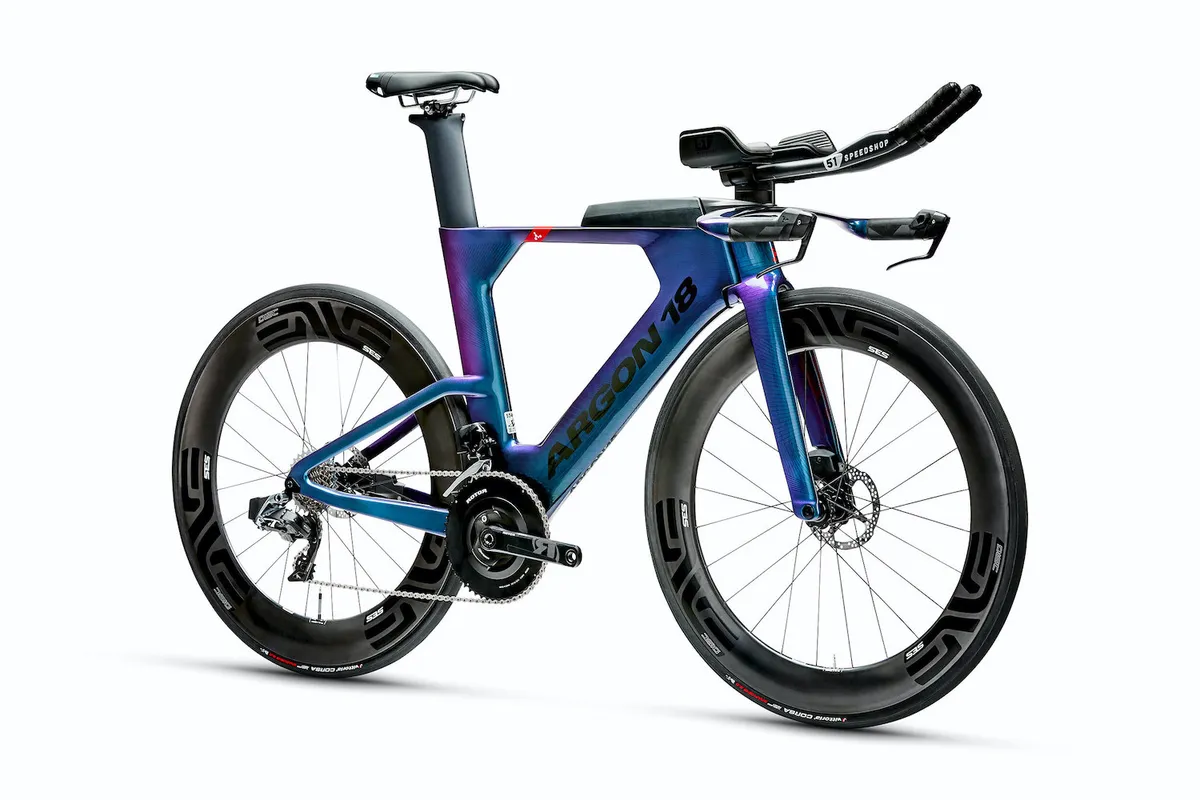
- Price: From £7,300
- Pros: Stable ride, versatile cockpit
- Cons: A bit weighty
Argon 18 claims its latest E119 Tri cuts 17 watts-worth of drag compared to its predecessor, and even the disc brakes are aero optimised with the callipers located inside the seatstay, a world first.
Clever downtube storage houses a full flat kit and there’s a roomy top tube box, too.
The cockpit takes some setting up as the bars put you in a very aggressive position, but this bike is a blast at high speeds and stable on descents.
The weight (over 9kg) is noticeable compared to some rivals, but dial in the front end the E119 absolutely flies on flat tarmac.
See our full Argon 18 E119 Tri Disc review for more.
Verdict: Innovative and aggressive superbike with some impressive features.
Score: 81%
Trek Speed Concept SLR 9
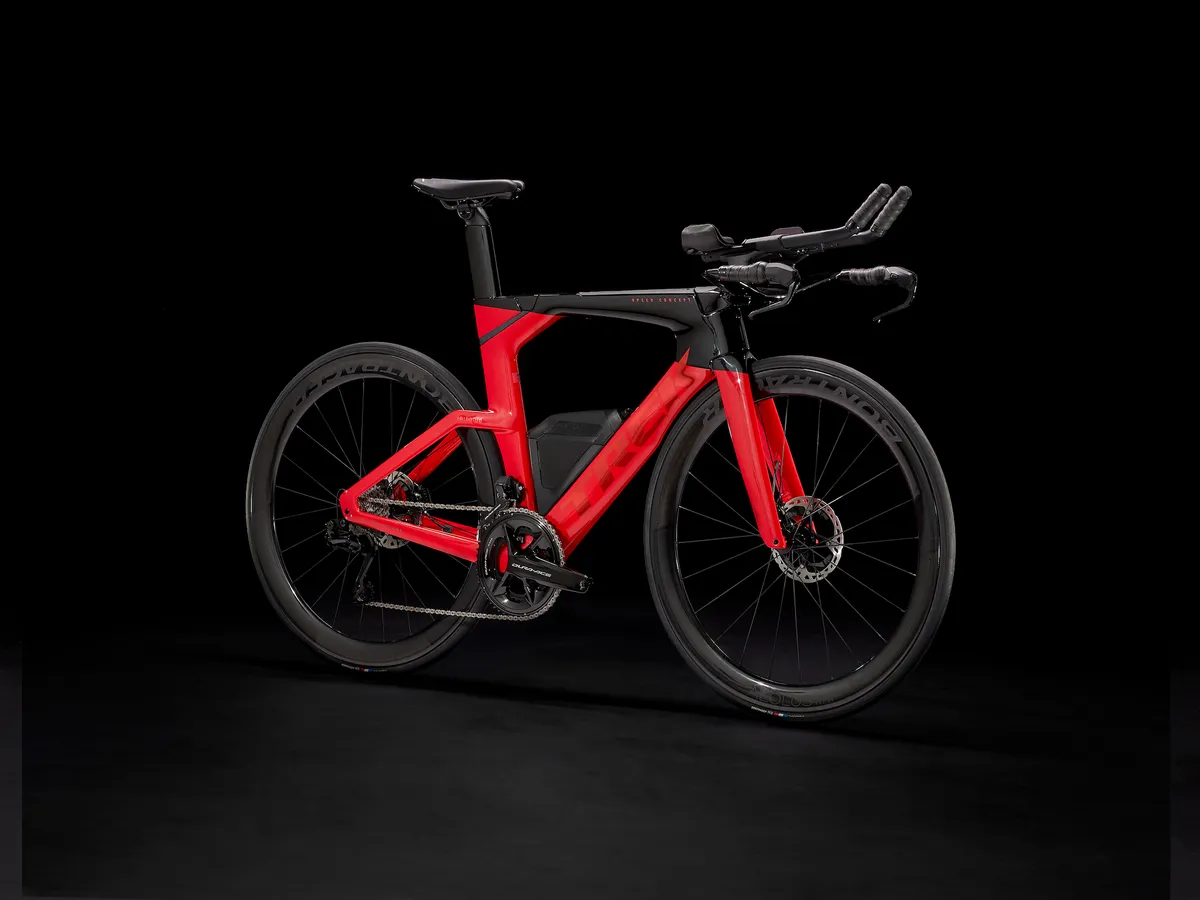
- Price: £12,300
- Pros: Great handling, very fast, light
- Cons: Very expensive, flat kit storage isn’t the best we’ve seen
Trek’s latest Speed Concept is one of the most impressive all-round tri packages we’ve seen.
The brand claims its IsoSpeed system adds a huge 30% more compliance and on the road we can definitely vouch for the excellent comfort offered over many miles, leaving you fresher for the run.
The storage and hydration is all included, and it’s completely ready to race with deep Bontrager aero wheels and a highly adjustable integrated cockpit.
If money is no object and you need to have one of the best triathlon bikes out there, the Speed Concept in this hero guise should certainly be on your wishlist.
Pop over to detailed Trek Speed Concept SLR 9 review for our full verdict.
Verdict: A truly top-of-the-range, cutting-edge triathlon superbike.
Score: 90%
Orbea Ordu M10iLTD
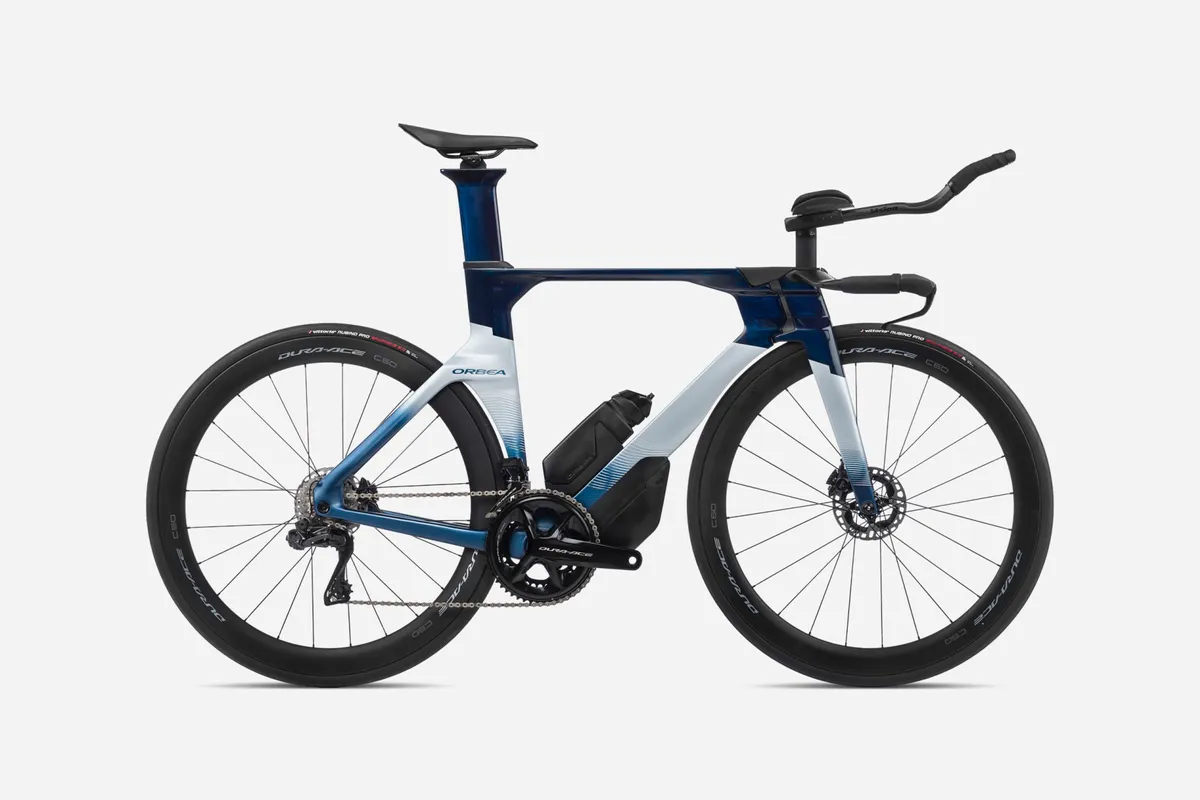
- Price: £11,499
- Pros: Nimble handling, great adjustability
- Cons: Lacks integrated storage options
The latest Ordu has a lower bottom bracket area for better weight distribution, a wind tunnel-optimised frame and the Ordu OMX integrated bar system, which has loads of adjustment options and can even flip over for an extra 30mm of height.
At 8.1kg it’s lighter than most modern tri bikes, so understandably climbs well and has nimble, lively handling.
You don’t get much storage other than a toolbox under the downtube, but Orbea says this is to give the rider more choice to fit their own.
If your budget won’t stretch to this, the Ordu starts from £6,999 with less luxurious components.
Give our Orbea Ordu M10iLTD review a read for more info.
Verdict: A highly adjustable racing machine with most bells and whistles you need.
Score: 84%
Quintana Roo PRsix2
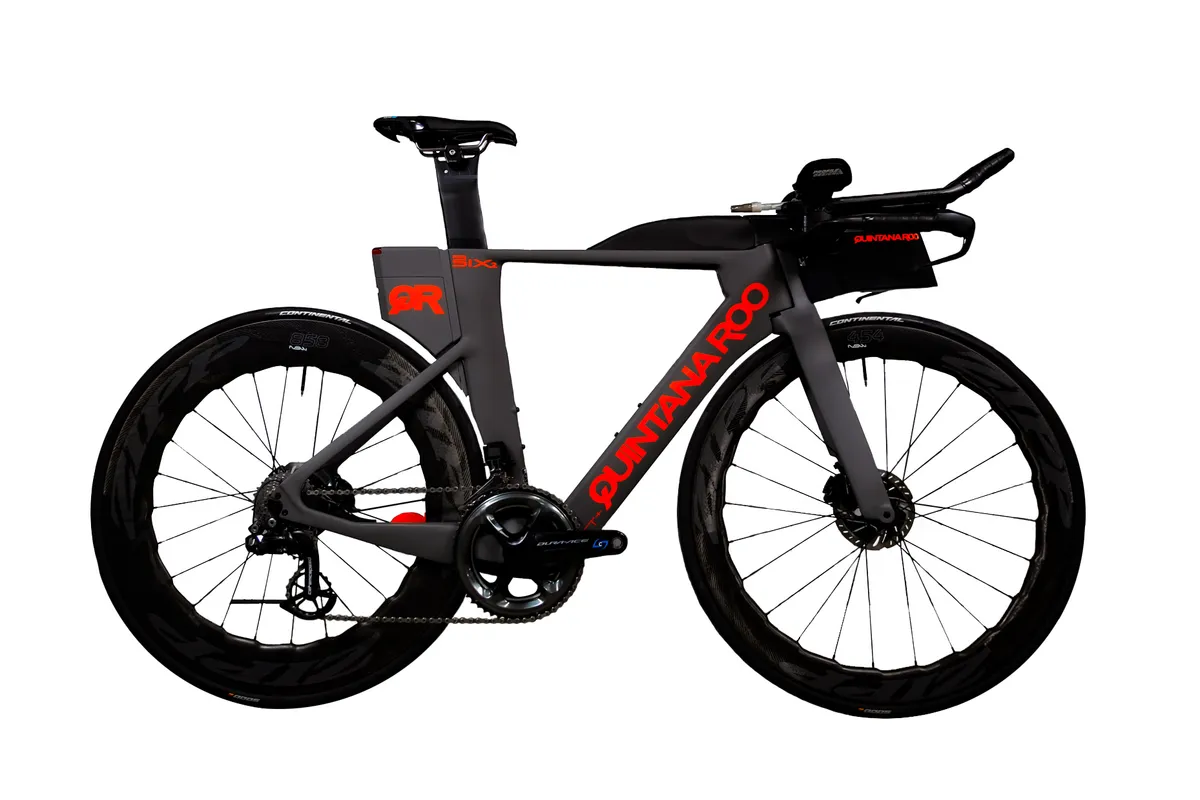
- Price: £3,799.95 (frameset)
- Pros: Stability, comfort, great storage options
- Cons: Weight
Joe Skipper’s bike of choice has unique asymmetrical chainstays, with the larger non-driveside chainstay and chunky tubes said to give a sail effect to help in crosswinds.
In testing we indeed found the PRsix2 incredibly stable with a familiar, planted ride feel that improves comfort and efficiency when trying to sustain a steady power output.
All storage and hydration is taken care of with a rear tool box, top tube pouch and hydration system.
A rarity in the UK, if you can get your hands on a PRsix2 you won’t be disappointed, with our only slight criticism being the 9.6kg weight.
Read our full Quintana Roo PRsix2 review here.
Verdict: Luxurious superbike ideal for going long.
Score: 91%
Cervélo PX-Series
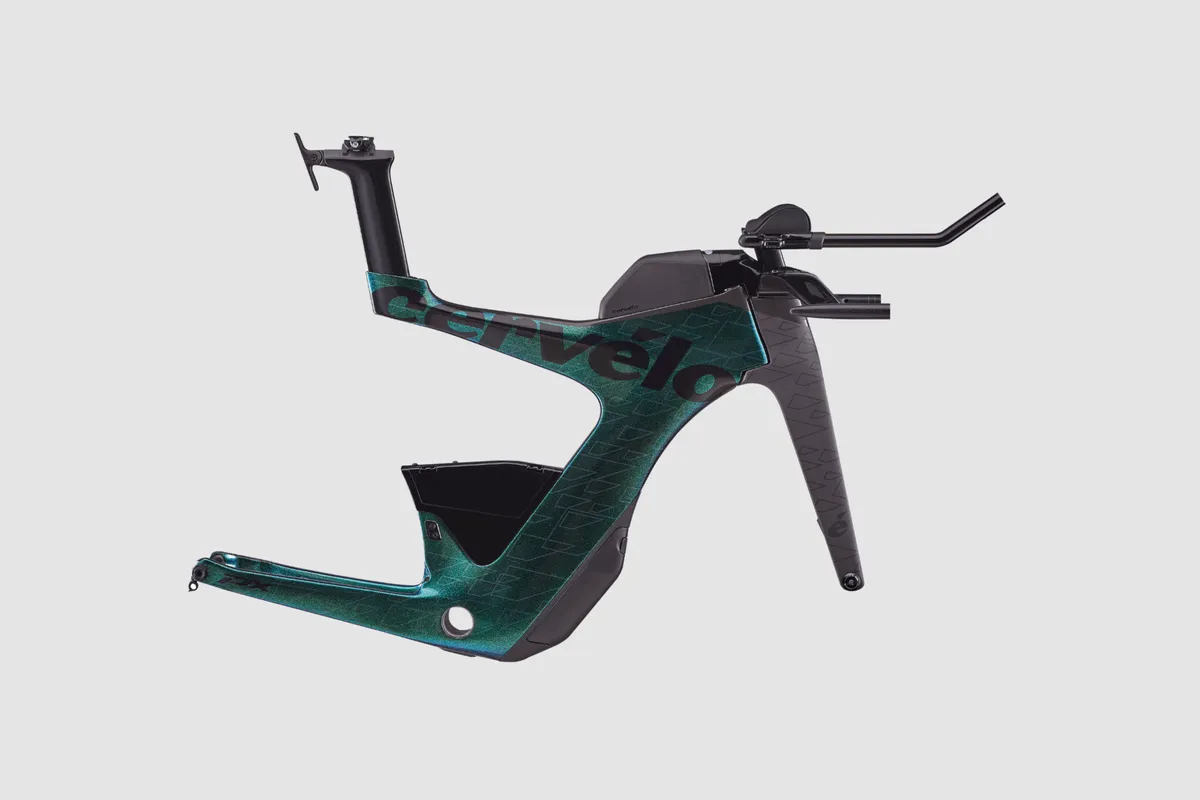
- Price: £5,019 (frameset)
- Pros: Unique, easy to adjust, plenty of storage
- Cons: On the heavy side
Cervélo’s PX-Series beam-shaped frame blew our minds when it launched seven years ago, and it’s still a weapon, but is now a fair bit lighter than when it was called the P5X.
We’ve always found the PX-Series bikes remarkably ‘normal’ to ride, with no flex apparent despite the missing seat tube.
There’s roomy top tube storage and a toolbox above the bottom bracket, and Cervélo’s split base bar with a mono riser system for the extensions makes fit and travelling with the bike easy.
At north of £10,000 for a full build, the PX-Series is for seriously competitive triathletes dreaming of an Ironman Worlds slot.
See our Cervélo P3X review here.
Verdict: Radical, rapid and well-handling tri superbike.
Score: 91%
Cervélo P-Series Ultegra
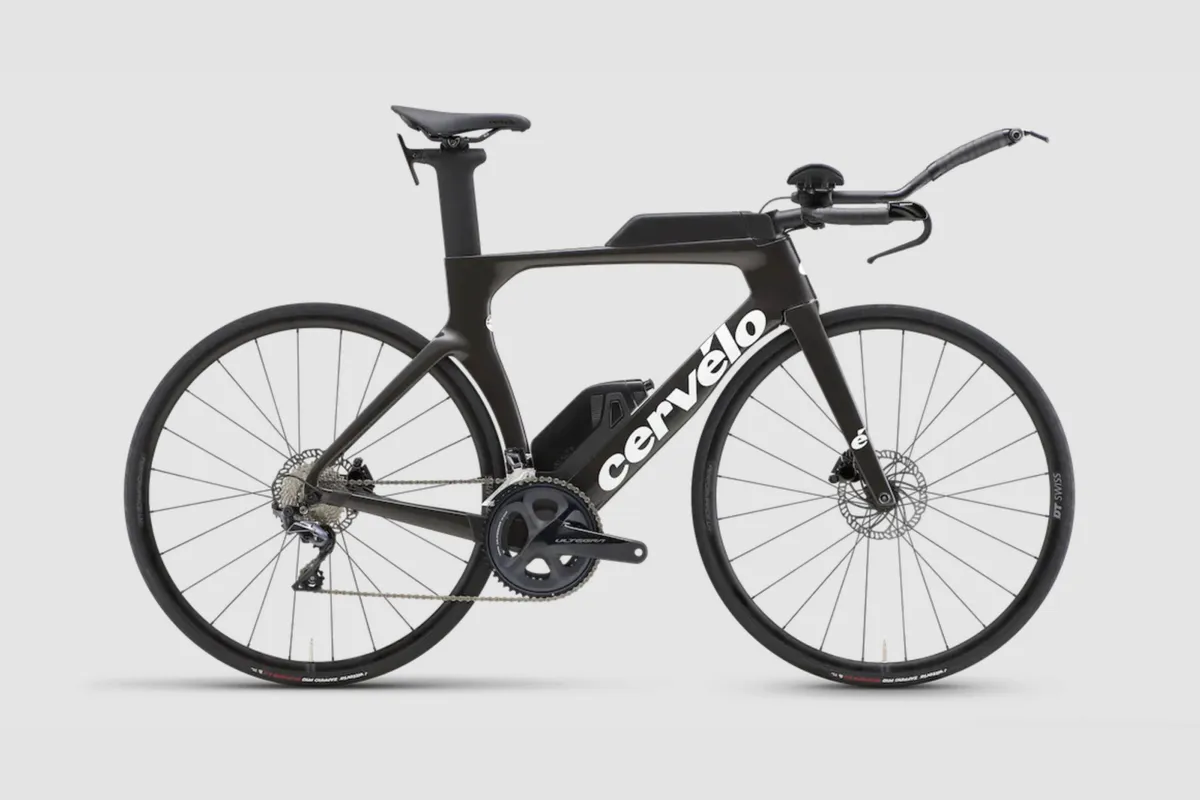
- Price: £4,500
- Pros: Forgiving geometry, good hydration and storage
- Cons: Entry-level wheels will need upgrading
If your budget won’t stretch to Cervélo’s PX-Series, the P-Series is the sensible choice if you want to stick with the brand that’s been the most popular at the Ironman Worlds for years.
In this build with mechanical Shimano Ultegra shifting, you get hydraulic disc brakes, top tube storage and even an aero bottle on the downtube.
The full carbon frame is aero as you’d expect, but the geometry and fit options offer day-long comfort, which is ideal for long-course debutants.
Everything on the P-Series is dependable and ticks all the speed, comfort, storage and practicality boxes we’d want for triathlon.
For a more detailed verdict, read our full Cervélo P-Series Ultegra review.
Verdict: A great versatile machine from triathlon’s most popular bike brand.
Score: 85%
Vitus Auro Disc Rival AXS
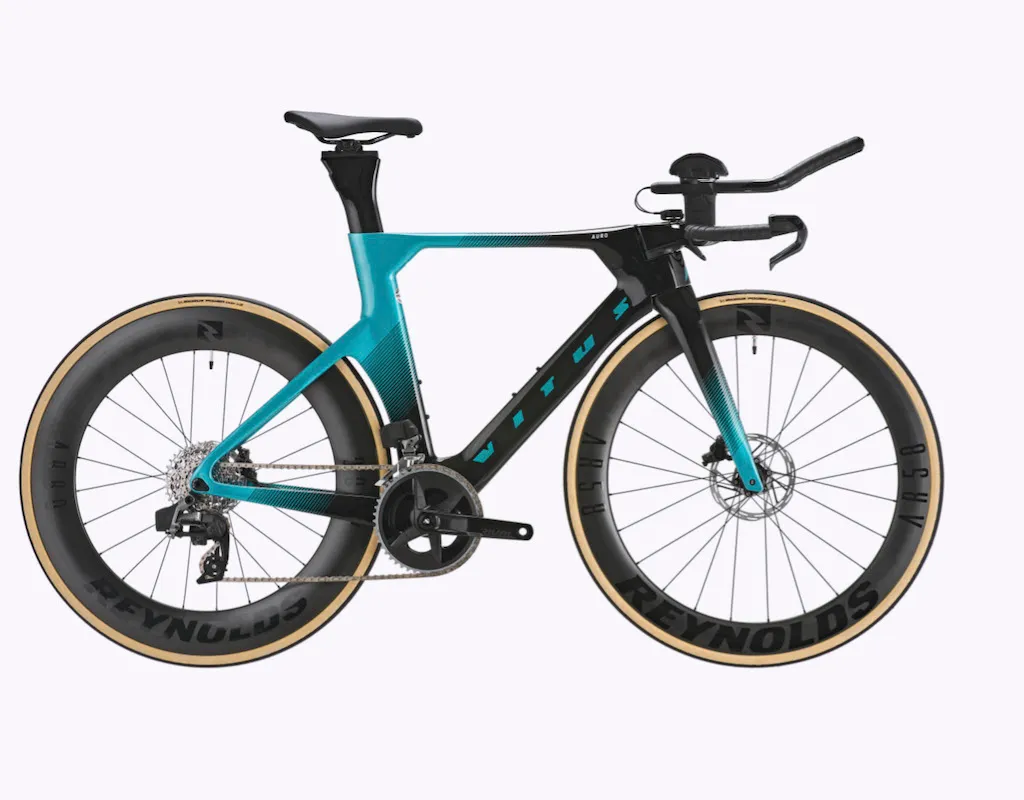
- Price: £4,699.99
- Pros: Good value, crisp shifting, great handling
- Cons: Lacks integrated storage
The Vitus Auro Disc has many notable improvements over its rim-brake predecessor, and not just in the braking department.
Other notable changes include updates to the stem (some not so great) and a newly integrated seat clamp that can be accessed beneath the top tube.
The Auro features a unidirectional carbon frame and, while there are bottle bosses, there’s no integrated storage.
The SRAM Rival AXS groupset delivers crisp shifts but annoyingly lacks shifting points on the base bar. Meanwhile, the chainring sizes (35/48) might not be optimal for flat courses, as it can be easy to spin out.
The tubeless Reynolds AR58/AR80 wheelset clad with 25mm rubber is quick and the Auro handles well on hilly routes thanks also to an increase in stiffness.
All in all, it feels like good value at £4,699.99 for a complete bike or £1,999.99 for a frameset.
Verdict: A great package that's ripe for upgrades. See our full Vitus Auro Disc Rival AXS review for more.
Score: 82%
Ribble Ultra Tri Disc
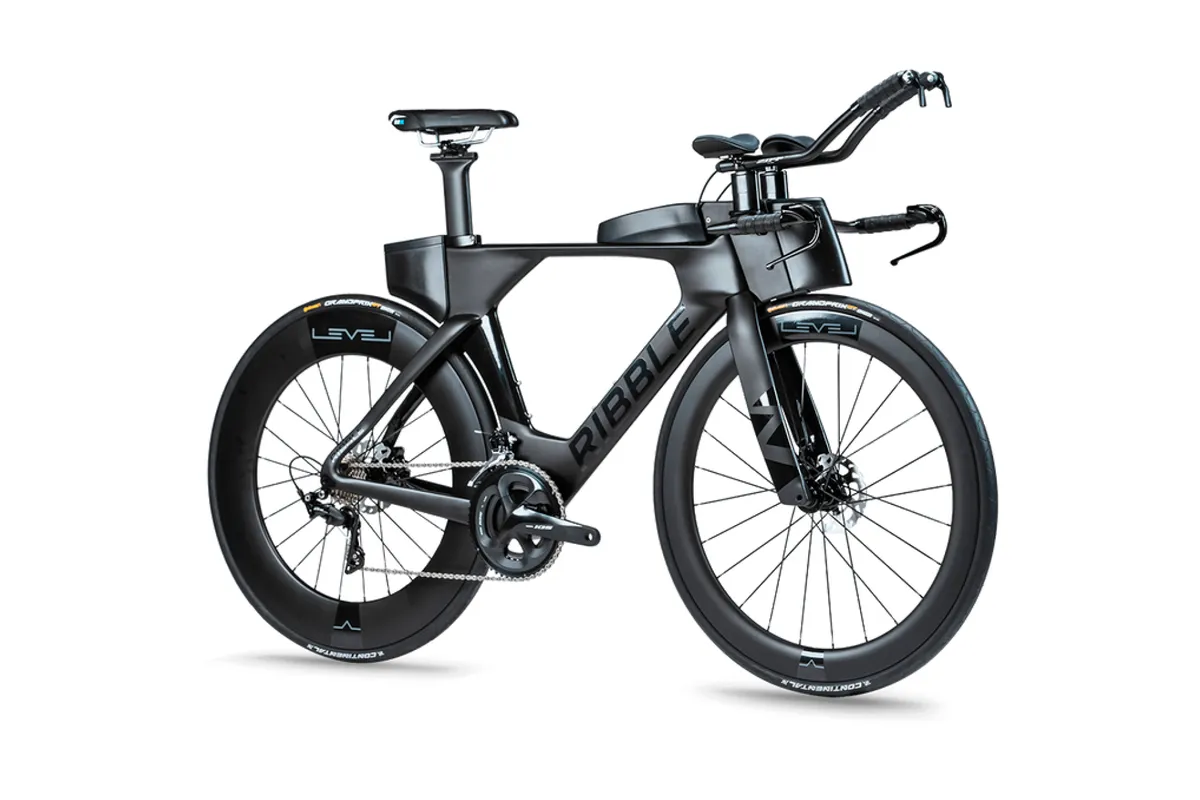
- Price: From £3,799.99
- Pros: Accessible price points, race wheels included, plenty of storage
- Cons: You can get cheaper tri bikes
Ribble’s Ultra Tri has had an inevitable disc brake makeover since we reviewed it, but maintains many of the features that impressed and remains good value for money.
It’s also very slippery, claims Ribble, showing significant drag savings in CFD and real-world testing against the base Ultra TT frame without accessories attached and an initial prototype.
Deep aero wheels from Ribble’s house brand Level are included on the most affordable version with mechanical Shimano 105 gearing, but you can get 12-speed electronic shifting if you pay more.
Whichever spec you go for, the Ultra Tri Disc is ready to set your bike split PB.
Verdict: Top aero tech at a more palatable price.
Score: 91% (for the older rim-brake version)
Giant Trinity Advanced Pro 2
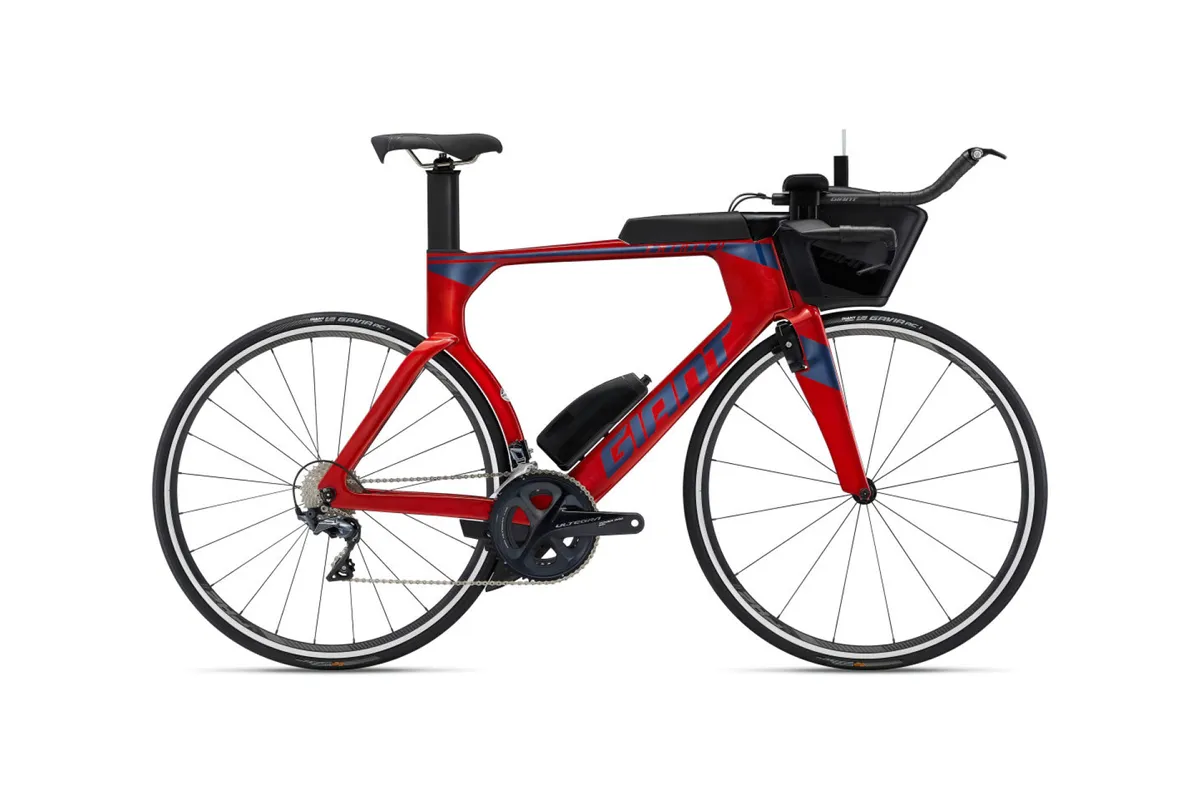
- Price: £3,499
- Pros: Affordable, highly regarded among aero experts
- Cons: Rim brakes not as powerful as disc brakes
We’ve reviewed the entry-level version of the legendary Giant Trinity, but have chosen this upgraded version as our recommendation due to the superior groupset, more advanced carbon fork and integrated hydration.
Giant’s ‘Aerosystem’ shaping technology incorporates CFD and wind tunnel testing to ensure the frameset is aero-optimised, and on the road that will definitely be apparent as the Trinity is wickedly fast.
Even the hydration system is made to slice through wind, and the reversible base bars allow for lots of adjustment.
Upgrade the wheels and this version of the Trinity is an absolute bullet at half the price of some rivals.
Verdict: The bike of choice for many TT specialists, and for good reason.
Score: 78% (for the entry-level version)
Orro Venturi Tri
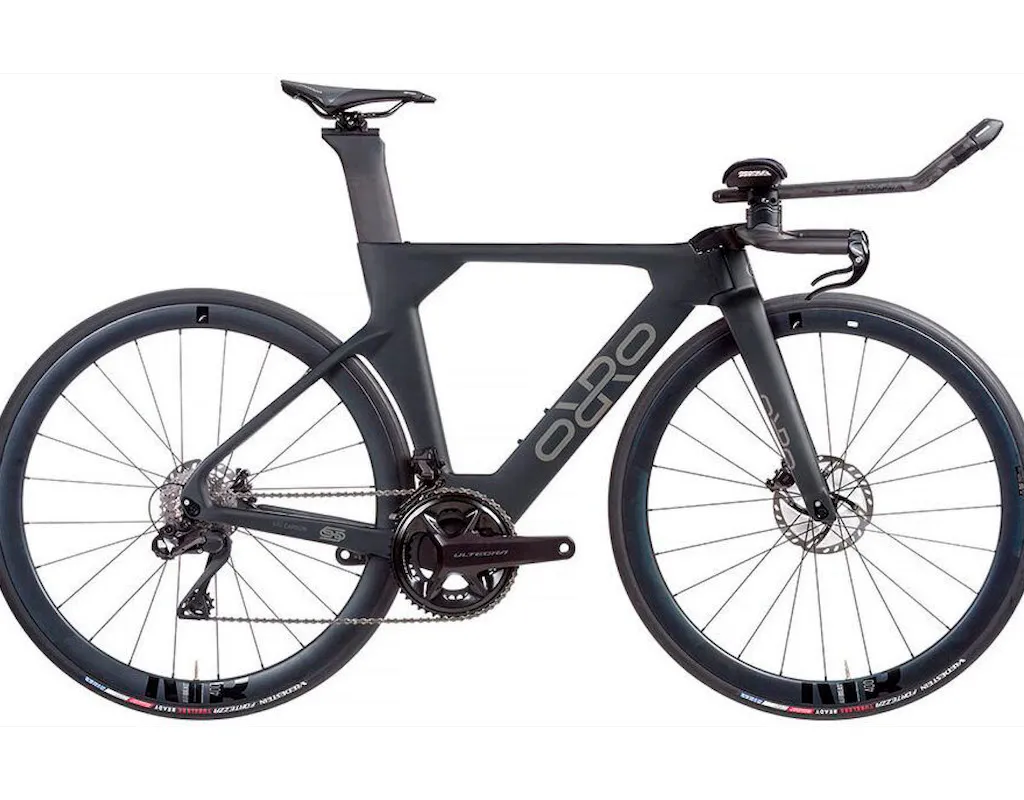
The bike boasts rounded leading edges and uses Sigmatex Spread Tow carbon fibre for the frame.
The design includes a bayonet-style fork and cockpit that, for the most part, delivers decent adjustability.
On that note, the seatpost offers ample fore-aft adjustment, while there’s 100mm of travel from the seatpost itself. You then get additional adjustment from the saddle’s rails.
The bike holds speed well and performs well in climbing and descending, with Shimano's Ultegra Di2 groupset delivering seamless shifting.
It's easy to travel with, and there are mounting options for hydration and storage, though nothing integrated.
Verdict: Overall, a solid tri bike with thought-out features. Read our full Orro Venturi Tri review for more.
Score: 82%
How we tested
Most of the triathlon bikes we've reviewed over the years have been tested by former 220 Triathlon staff writer Jack Sexty.
Jack has been testing bikes for a decade and has been racing triathlon competitively for even longer. He's also editor of Road.cc, so it's fair to say he knows his stuff.
Every bike reviewed here has been tested with a substantial amount of riding, including long rides of several hours.
Our testing and scoring takes into account key criteria such as fit (and how adjustable the bike is), comfort, stiffness, integrated storage and, of course, speed.
Other things we consider include how fresh we feel running off the bike after a ride, the quality of the finishing kit, how easy it may be to pack down and transport and value for money.
For more detail on all of this, scroll down and read through our guide to the features of a triathlon bike.
Our ratings take all of the above into account. Anything over 90% is considered a genuine class leader, 80-89% is still one of the best you can buy, while 70-79% is represents a bike that is still a decent performer.
The birth of triathlon bikes
We have two Americans to thank for the triathlon bike: Dan Empfield and Ray Browning. Empfield founded Quintana Roo in 1987 to build wetsuits specifically for triathletes. That same year the Scott DH aerobar began appearing on bikes at triathlons.
But although the DH bar offered an aerodynamic advantage, it came at a cost, as the Quintana Roo company history explains: “The problem was that it wasn’t very comfortable; the slack seat-tube angle and the fixed quill stems of the bikes of this time meant there was little room for adjustment. To achieve a good aero position, riders were bending over almost completely double.”
Empfield noticed that athletes using the DH bars would move their saddles forwards to get more comfortable and this got him thinking about altering the typical road bike frame geometry with its 73–78° seat-tube angle.
Meanwhile Browning, a successful triathlete studying for a PhD in biomechanics at UCLA, had found that riders could pedal harder by bringing their hips forwards to effectively steepen the seat-tube angle. He also believed that the more open hip angle such a position created would allow riders to run better after riding.
Empfield and Browning joined forces to put their theories to the test. Empfield built the QR Superform, with 650c wheels, aerobars and, more importantly, an 80° seat tube. Browning rode it at 1989’s Ironman New Zealand to see if this ‘tri-specific’ geometry worked. It did. He finished the bike leg 30mins ahead of two-time Ironman World Champion Scott Tinley and went on to win, breaking the course record in the process.
Thanks to advances in materials, design methods and our understanding of low-speed aerodynamics, triathlon bikes have continued to be refined since that initial outing in 1989. But their purpose remains the same: to get you to T2 as fast as possible while preserving your ability to run.
Time then to look at today’s innovations and just whether you need to be adopting the aero tuck this summer…
Features of a triathlon bike
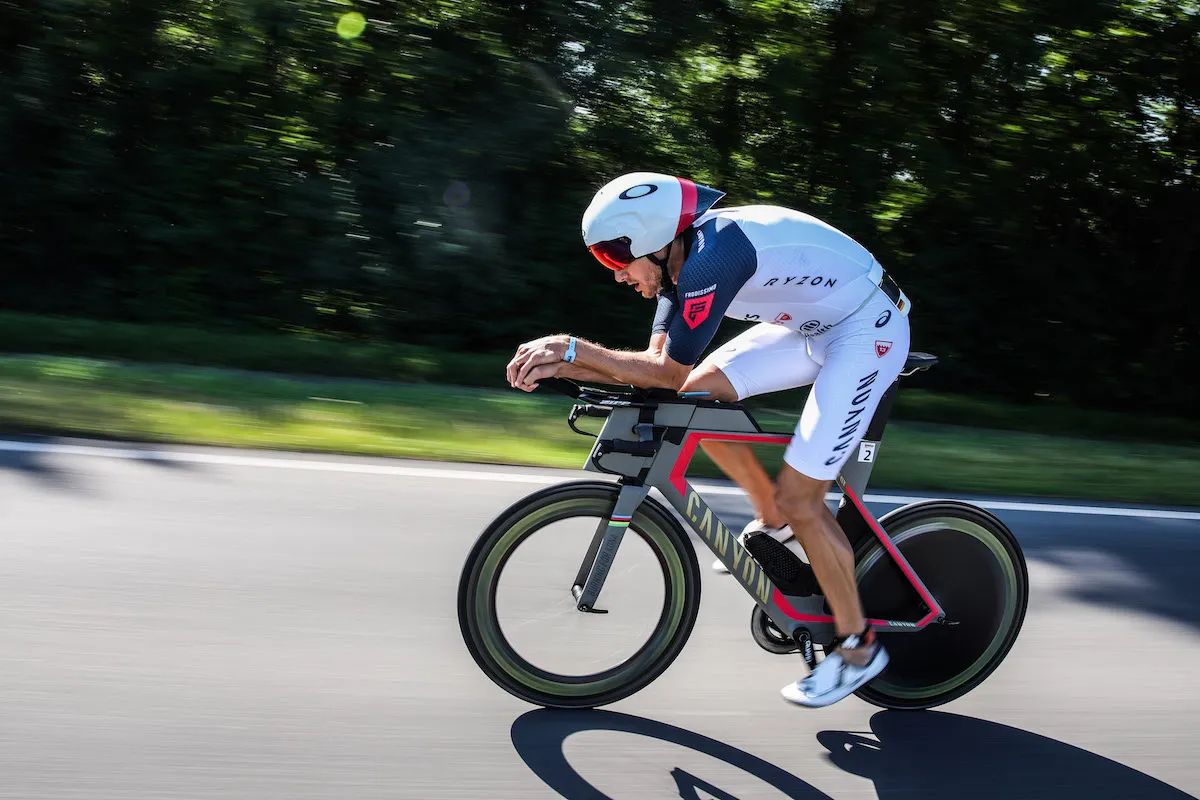
Certain characteristics are found on every tri bike, no matter what maker’s name appears on the frame…
Aerobars
Aerobars put you in a more aerodynamic riding position than conventional handlebars. While a road bike’s ‘drop’ bars may allow you to lower your head and flatten your back, aerobars also enable you to tuck your arms and elbows in.
In this sort of aero tuck position, you present a smaller, narrower profile to the air you’re trying to push out of the way.
Frame
Without being bogged down by the UCI rules governing tube dimensions that road race and time trial frames must adhere to, tri-specific bikes are free to use almost any size and shape of tube they like.
Hence the broader down tubes and head tubes with long trailing edges seen on the likes of the Felt IA.
More radical designs do away with certain tubes altogether, such as Kristian Blummenfelt’s Cadex tri bike, which comes without a traditional top tube.
Seat-tube angle
The hallmark of a triathlon bike is a steep seat-tube angle. Whereas road bike seat tubes tend to sit on a spectrum between 72° and 75°, the seat tubes on tri bikes typically start at 75° and can go up beyond 80°.
The steeper angle moves the rider further forward, making it easier to ride in a tuck position on the aerobars, and opens their hip angle, allowing athletes to pedal harder.
Saddle
Given that both their bike and bars put triathletes in a different riding position to other types of cyclists, the next logical component to consider tailoring to their needs is the saddle.
To that end, more stub-nosed, grooved and pronged saddles are appearing on tri-specific bikes to eliminate, or at least minimise, the discomfort that riding in a low-profile tuck can cause.
The various designs are intended to relieve pressure on the rider’s perineum by supporting their weight on their ischial tuberosities (sit bones) instead.
Storage
Getting through a long-distance bike leg means carrying fuel, tools and spares, so storage is a concern on a tri-specific bike. Stuffed jersey pockets and a pair of bottle cage mounts will do the job, but there are better ways to solve the problem.
Drinking systems mounted between the aerobars or, better still, integrated into the frame, provide convenient, aerodynamic options.
Meanwhile, carefully shaped containers such as top-tube boxes or storage integrated into the top tube allow for easy access to nutrition, while some triathlon bikes now also make space for tools and a flat kit in the frame itself.
Brakes
Despite the presence of levers, it can often appear as though triathlon bikes don’t have any brake callipers. Aerodynamics is the reason for their apparent invisibility as bike designers look for ways to keep them out of the airflow.
Hiding the front brake behind the fork or integrating it into the fork’s structure is a popular solution, as is mounting the rear brake behind the bottom bracket, underneath the chainstays.
Of course, many triathlon bikes also now come with disc brakes.
How much time can you save on a triathlon bike
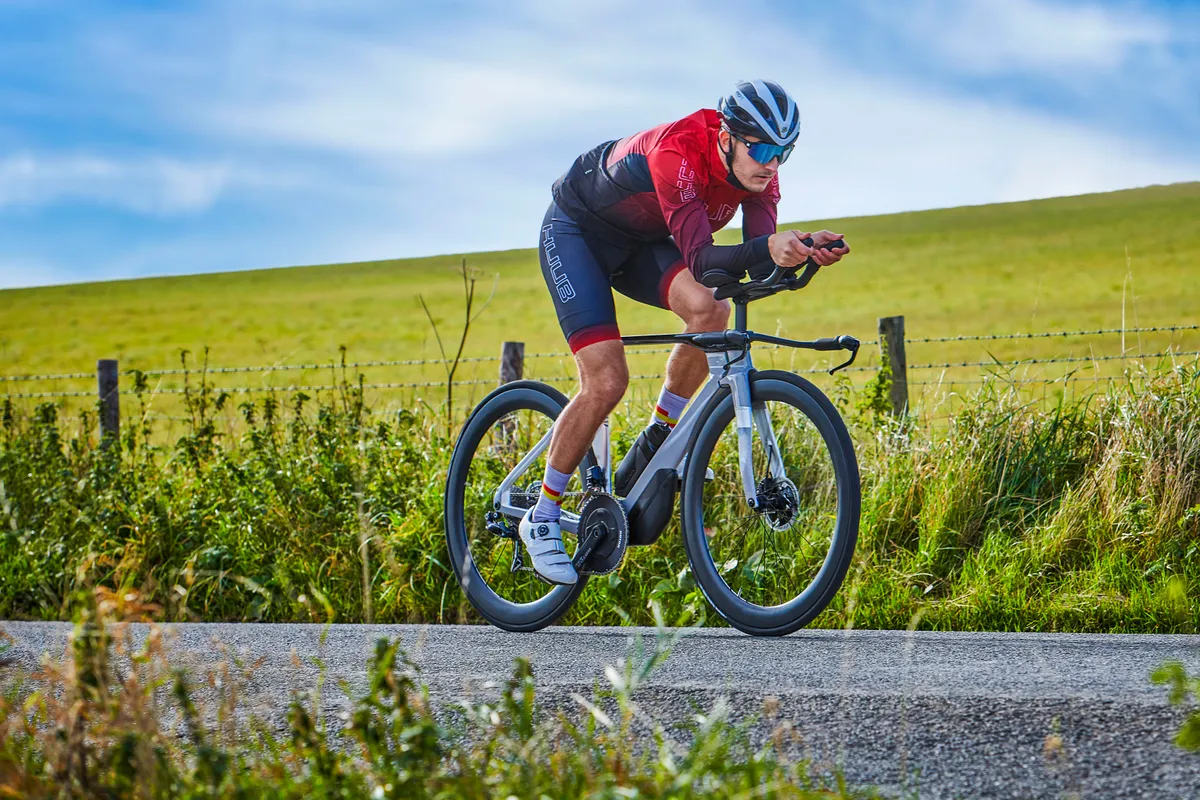
Given the specific job a triathlon bike has to do, how much of a difference can one make compared to a normal road bike with or without aerobars?
“For the same rider [whose body and position is the cause of the largest proportion of the total drag] on all three bikes, a road bike without aerobars can generate as much as 20–25% more drag,” says Trek’s Carl Matson.
“[That] sounds like a huge number and it is. Even if you can stay down in the drops for the entire ride, you’re presenting more frontal area and non-aero shapes to the wind due to the wide arm position.”
Clip-on aerobars will help to reduce that number, but even with them it’s still difficult to reproduce a triathlon bike’s riding position without a forward-angled seatpost and non-standard stem.
“[Assuming] a rider can achieve the same position on a road bike with clip-on aerobars as they can on a tri bike,” continues Matson, “any remaining aerodynamic differences would be down to the bikes themselves. In this context, a tri bike’s advantage would be reduced but if the rider’s on a Trek Speed Concept, they’ll be producing 3–5% less drag.”
Whether those figures come from real-world testing or the controlled conditions of a wind tunnel, they make a convincing argument for using a triathlon bike, especially in long-distance races where efficiency is a greater priority than sheer power.
When should you not use a triathlon bike?
The specific nature of their design also makes triathlon bikes ill-suited in certain situations, such as races with hilly or technical bike courses.
Triathlon bikes fail to shine on such courses because the extra material required to make them aerodynamic adds weight, and their ‘pitched forwards’ riding position leads to awkward handling.
Furthermore, all the extra components that make up a tri bike’s cockpit reduce the clearance for your knees and wrists when you want to get out of the saddle to climb or accelerate.
Top image credit: Ezra Shaw/Getty Images for Ironman
